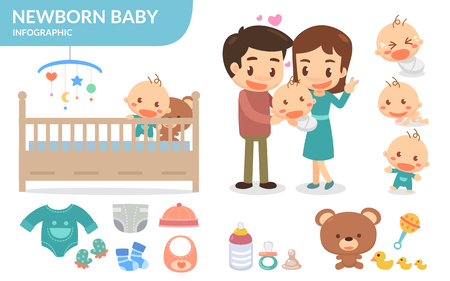Introduction to Food Allergies in Babies
Weaning is an exciting milestone for both babies and parents in the UK, but it can also raise concerns about food allergies. With a rising awareness of allergy risks, it’s essential to recognise the signs early when introducing new foods. In the UK, some of the most common allergens affecting infants include cow’s milk, eggs, peanuts, tree nuts, soya, wheat, fish, and shellfish. Early identification during weaning is crucial as prompt action can prevent severe reactions and help you manage your child’s diet safely.
| Common Allergen | Typical Onset Age | Possible Symptoms |
|---|---|---|
| Cow’s Milk | Before 1 year | Rash, vomiting, diarrhoea |
| Eggs | 6–12 months | Hives, swelling, breathing difficulties |
| Peanuts & Tree Nuts | 6–12 months | Swelling of lips/face, rash, anaphylaxis |
| Soya & Wheat | 6–12 months | Skin reactions, gastrointestinal upset |
| Fish & Shellfish | After 8 months | Nausea, hives, breathing issues |
The importance of understanding these allergies cannot be overstated. Early recognition means families can seek advice from their GP or health visitor without delay, ensuring the baby receives safe nutrition and care throughout the weaning process. Being informed helps you create a safer environment while still letting your little one explore new tastes and textures confidently.
2. Recognising Early Signs and Symptoms
During the weaning process in the UK, it is crucial for parents and carers to be able to spot the early signs of food allergies in babies. Typical allergic reactions can vary from mild to severe, and being vigilant is essential for your babys safety and wellbeing.
Common Allergic Reactions in Babies
| Symptom | Description |
|---|---|
| Skin reactions | Redness, hives, or a rash around the mouth or body |
| Gastrointestinal issues | Vomiting, diarrhoea, or persistent tummy pain |
| Respiratory symptoms | Runny nose, sneezing, coughing, or wheezing |
Red-Flag Symptoms to Watch For
- Swelling of the face, lips, tongue, or eyes
- Difficulty breathing or noisy breathing (stridor)
- Pale or blue skin (cyanosis)
- Lethargy or sudden floppiness
When to Seek Immediate Medical Help
If your baby shows any signs of a severe reaction such as trouble breathing, swelling of the face or mouth, becoming floppy or unresponsive, call 999 for emergency medical help immediately. These could be indicators of anaphylaxis—a life-threatening allergic reaction that requires urgent intervention. For less severe but concerning symptoms, contact your GP or NHS 111 for further advice. Prompt action ensures your child receives the right care at the right time.

3. Common Allergenic Foods Introduced During Weaning
When it comes to weaning in the UK, certain foods are more likely to cause allergic reactions in babies. It’s important for parents and carers to be aware of these common allergens and to introduce them safely and gradually. The following table highlights some of the most frequently encountered allergenic foods in the UK, along with practical tips for their introduction:
| Allergenic Food | When to Introduce | Tips for Safe Introduction |
|---|---|---|
| Cow’s Milk | After 6 months (not as a main drink until 12 months) | Start with small amounts mixed into cooked foods; watch for reactions such as rash, vomiting or diarrhoea. |
| Eggs | After 6 months (fully cooked) | Introduce well-cooked eggs first (e.g., scrambled or hard-boiled); offer a tiny amount and wait a few days before increasing. |
| Nuts (including peanuts) | After 6 months (as smooth nut butter or ground nuts) | Never give whole nuts due to choking risk; start with a pea-sized amount of smooth nut butter mixed into other foods. |
| Fish & Shellfish | After 6 months (well-cooked, boneless) | Introduce one type at a time; avoid raw or lightly cooked shellfish. |
| Soya | After 6 months | Try soya-based yoghurts or formula if needed; monitor closely for any signs of intolerance. |
| Wheat (Gluten) | After 6 months | Add small amounts of wheat-based cereals or bread; introduce only one new food at a time. |
Gradual Introduction: A Safety-First Approach
The British Dietetic Association recommends introducing allergenic foods one at a time, leaving three days between each new food. This helps you spot any delayed reactions and clearly identify the culprit if an allergy does develop.
If your family has a history of allergies, eczema, asthma, or hay fever, speak with your GP or health visitor before introducing allergenic foods. Always supervise your baby during feeding and keep an eye out for symptoms such as swelling, hives, difficulty breathing, or persistent vomiting.
4. Safe Weaning Practices to Minimise Allergy Risks
Weaning is an exciting milestone, but introducing new foods must be done with care to minimise the risk of food allergies. In the UK, experts recommend a set of best practices designed to help parents and carers identify potential allergens early and respond safely.
Best Practices for Introducing New Foods
Introduce single-ingredient foods one at a time, starting with small amounts. This approach helps you clearly identify any reactions linked to a specific food. Avoid mixing several new foods together, as this can make it difficult to pinpoint the source of any allergy symptoms.
Keeping a Food Diary
A detailed food diary is invaluable during weaning. Record every new food your baby tries, the time it was eaten, and any symptoms that occur within 48 hours. This log can help health professionals diagnose allergies more accurately if you notice a pattern.
Food Introduced |
Date & Time |
Portion Size |
Observed Reactions |
|---|---|---|---|
| Mashed peas | 1 June, 10am | 1 tsp | No reaction |
| Egg (well-cooked) | 4 June, 10am | ½ tsp | Mild rash on cheeks (consulted GP) |
| Porridge oats | 7 June, 9am | 1 tbsp | No reaction |
The Three-Day Rule Explained
The ‘three-day rule’ is a widely recommended strategy in the UK. After introducing a new food, wait three days before trying another unfamiliar item. This waiting period makes it easier to spot delayed allergic responses and reduces confusion about which food may be responsible for a reaction.
Key Steps for Safe Weaning:
- Start with low-allergen foods like vegetables and fruits commonly used in British diets (e.g., carrots, parsnips, apples).
- Always supervise your baby when trying new foods.
- If your child has siblings with allergies or if there is a family history of allergies, consult your health visitor or GP before introducing common allergens like peanuts or eggs.
- Keep emergency contact details handy and know the signs of severe allergic reactions (anaphylaxis).
By following these safe weaning practices—introducing foods slowly, keeping accurate records, and using the three-day rule—you’ll minimise risks and gain confidence as your baby explores new tastes and textures during their weaning journey in the UK.
5. What To Do If You Suspect an Allergy
If you think your baby is having an allergic reaction during weaning, it’s important to act quickly and safely. Here’s a practical guide based on UK recommendations:
Immediate Steps to Take
- Stop Feeding the Suspected Food: Immediately remove the food you believe caused the reaction.
- Observe Your Baby: Monitor for symptoms such as hives, swelling, vomiting, coughing, or difficulty breathing.
- Mild Symptoms: If symptoms are mild (such as a mild rash or small patches of hives), keep your baby under close observation and do not reintroduce the suspected food until you consult a healthcare professional.
- Severe Symptoms: If your baby develops severe symptoms (such as difficulty breathing, swelling of the face or tongue, or becomes floppy), call 999 immediately – this may be anaphylaxis and requires urgent medical help.
When to Contact Your GP or Health Visitor
The NHS recommends that you seek advice if your baby has possible signs of a food allergy. Use the following table for guidance:
| Symptom | What To Do |
|---|---|
| Mild rash/hives around mouth or body | Contact your GP or health visitor for advice before offering the food again |
| Vomiting/diarrhoea (not severe) | Monitor hydration; contact your GP if symptoms persist or worsen |
| Coughing, wheezing, difficulty breathing, swelling of lips/face/tongue, sudden drowsiness | Call 999 immediately – emergency situation |
NHS Guidelines for Allergy Management
- Avoid reintroducing the suspected allergen until assessed by a healthcare professional.
- Keep a food diary: Record what foods were introduced and any reactions observed; this will help your GP make a diagnosis.
- If prescribed antihistamines or adrenaline auto-injectors: Follow your GP’s instructions on how and when to use them.
Support from UK Services
- Your health visitor can offer weaning support and allergy information tailored to your baby’s needs.
- The NHS website provides up-to-date advice on managing allergies in babies and children.
- If you’re unsure about symptoms or need reassurance, don’t hesitate to ask for help from your GP practice.
Early action and proper communication with healthcare professionals help ensure your baby’s safety as they explore new foods during weaning in the UK.
6. Local Resources and Support Networks
Identifying and managing baby food allergies during weaning can be daunting, but parents in the UK have access to a variety of local resources and support networks. Utilising these services ensures you’re not facing challenges alone and provides reliable, up-to-date guidance specific to UK standards.
NHS Support Services
The NHS offers comprehensive advice and support for parents dealing with food allergies. You can speak to your GP or health visitor if you suspect your baby is having an allergic reaction. They may refer you to a specialist allergy clinic for further testing and management. The NHS website also provides detailed information on recognising symptoms, safe weaning practices, and emergency procedures.
NHS Helplines
| Service | Contact Information |
|---|---|
| NHS 111 (Non-Emergency) | Call 111 or visit 111.nhs.uk |
| NHS Allergy Services | Contact via your local GP surgery or find details at NHS Allergies |
UK-Based Allergy Support Groups
Several national charities and organisations provide practical advice, emotional support, and community forums for families dealing with childhood food allergies. These groups often offer downloadable resources, helplines, and opportunities to connect with other parents who share similar experiences.
Key Organisations
| Name | Description | Website |
|---|---|---|
| Allergy UK | Helpline, factsheets, and local support groups for families managing allergies. | allergyuk.org |
| Anaphylaxis UK | Specialist charity focused on severe allergies; offers training and support resources. | anaphylaxis.org.uk |
Community Support Networks
Many communities across the UK have parent-led groups on social media platforms like Facebook or local online forums such as Mumsnet. These groups are valuable for sharing experiences, tips on reading UK-specific food labels, and recommendations for allergen-friendly products available in British supermarkets. Always ensure the advice shared aligns with official NHS or registered charity guidelines for safety.
If you’re navigating the challenges of identifying baby food allergies during weaning, reaching out to these trusted UK resources provides reassurance, expert advice, and a supportive network throughout your journey.


